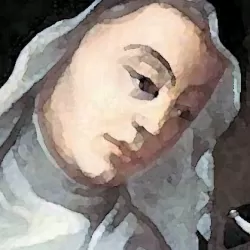Few Saints hold greater attraction for Carmelites of the Ancient Observance than Saint Mary Magdalen de’ Pazzi.
Feast Day: May 25
Few Saints hold greater attraction for Carmelites of the Ancient Observance than Saint Mary Magdalen de’ Pazzi. Her twenty-five years of religious life, begun in 1582 at the age of sixteen, were spent entirely in a convent of their observance, Saint Mary of the Angels in Florence.[1] The mystical phenomena in her life, the spiritual wisdom of her writings, and, above all, the angelic sanctity which led to her official canonization by Pope Clement IX in 1669 have made her one of Carmel’s brightest lights and best-loved Saints.
...the lives and writings of ... [St. Teresa of Avila and St. Mary Magdalen de'Pazzi] are of one piece in calibre and stature.
Saint Mary Magdalen entered the Order the very year another, more widely-known Carmelite mystic, Saint Teresa, died. Her life and works were to continue the same high ideals of Carmel which were given new life by her illustrious predecessor. Probably Saint Mary Magdalen never heard of her Spanish Carmelite sister; today many outside the Order are familiar with Saint Teresa, but scarcely aware of “La Santa di Firenze”; yet the lives and writings of the two Saints are of one piece in calibre and stature. It is for Carmelites, especially those of the Ancient Observance, to present this fact to the world.
The bibliography on Saint Mary Magdalen is by no means as extensive or as scholarly as that concerned with Saint Teresa. Biographical and devotional literature exists in abundance, especially in Italian, though also in other languages by way of translation, but the larger part of this is diffuse and repetitious and nothing to the two contemporary biographies of the Saint, those of Puccini and Cepari.[2] Saint Mary Magdalen emerges from the pages of these books as an extraordinary prodigy of the supernatural — which she was — but unreal, unappealing, without human qualities, hardly the robust girl of strong features and dark piercing eyes whose authentic portrait still exists in the convent in Florence. One reads these books without enlightenment and without a deeper understanding of the Saint.
There are, however, some notable exceptions to this type in some of the modern, popular biographies of the Saint, in the anonymous Santa Maria Maddalena de’ Pazzi,[3] in La Santa di Firenze, which was also published anonymously,[4] in Vaussard’s life of the Saint,[5] or in Raphael Cione’s short but illuminating introduction to his collection of selected critical texts of the Saint’s writings.[6] Any of these four books might serve as an easy introduction to the Saint; each gives an accurate if cursory survey of her life and doctrine. Unfortunately none of them has as yet found its way into English.
The two most important books about St. Mary Magdalen
remain the original biographies by (1) Vincent Puccini, the last ordinary confessor of the Saint, and (2) Virgil Cepari, S.J., her last extraordinary confessor.
But the two most important books about Saint Mary Magdalen remain the original biographies. Vincent Puccini, the last ordinary confessor of the Saint, wrote her life in 1609, and two years later edited her personal accounts of the ecstasies she experienced and added these to the second edition of his work. Virgil Cepari, S.J., the last extraordinary confessor, began publication of her life in 1626, but it was not until 1669 that his work was completed, the last fifteen chapters being written by Joseph Fozi, S.J. Both books, which have gone through numerous editions and translations, are the primary printed sources for a study of the Saint. Each has the merits of contemporary and eye-witness reports. Their shortcomings, which were to characterize subsequent biographies as well, are due to faulty hagiographical standards; there is an overemphasis on the extraordinary, a failure to place events in their proper setting, and a neglect of the personality of the Saint. Cepari seems to have organized his material more neatly, set down facts in better chronology and sequence, and, in general, presented a more readable life, but both biographies are authoritative and deserve a careful reading.
Puccini’s edition of the Saint’s writings has been the source for most of the other editions of her works. This is indeed unfortunate, since his edition mutilated the original text. He added and deleted where he willed, joined different compositions on the same subject, bowdlerized strong statements of the mystic, and inserted pious reflections of his own. Such a method could not but give an unsatisfactory text, not only from the view point of the genuine thought of the Saint, but even for the style of her writings. Certain critics have found her writings heavy and uninspiring, traditional in their pietistic and devotional preoccupation, dry in their scholastic division into points.[7] Puccini’s method is at least partially responsible for this unfavorable criticism, a criticism that is not warranted by the original text. Recently selected passages taken from the manuscript accounts of the Saint have been published.[8] The manuscripts, five large volumes written in the careful hand of the sisters in the convent appointed to be secretaries of the Saint, still exist in good condition in the convent in Florence. Their publication may well be the beginning of a more extensive and a deeper study of the real contribution of this Saint.
[We hope for] a new edition of her works and a serious
investigation by Carmelite scholars of her mystical life and doctrine...
Saint Mary Magdalen deserves to be better known, both inside and outside the Order. It is said that Saint Gertrude was relatively unknown until two-and-a-half centuries after her death, when the first readable edition of her works was published.[9] It is now a little over three centuries since the death of Saint Mary Magdalen de’ Pazzi. May we not hope that a new edition of her works and a serious investigation by Carmelite scholars of her mystical life and doctrine will vastly increase her influence in the Church? What are we waiting for?
Footnotes











